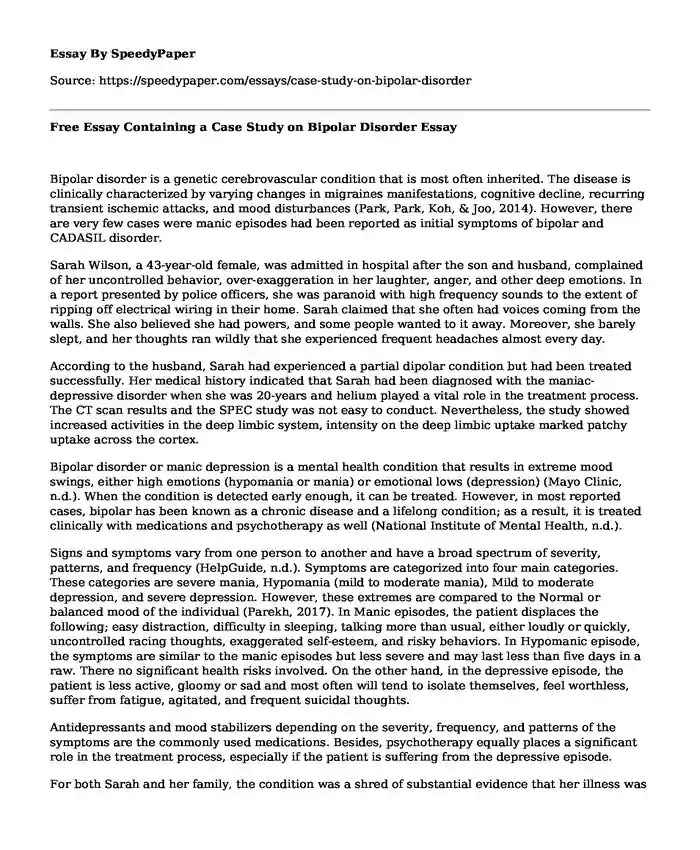
| Type of paper: | Case study |
| Categories: | Mental health Bipolar disorder |
| Pages: | 3 |
| Wordcount: | 715 words |
Bipolar disorder is a genetic cerebrovascular condition that is most often inherited. The disease is clinically characterized by varying changes in migraines manifestations, cognitive decline, recurring transient ischemic attacks, and mood disturbances (Park, Park, Koh, & Joo, 2014). However, there are very few cases were manic episodes had been reported as initial symptoms of bipolar and CADASIL disorder.
Sarah Wilson, a 43-year-old female, was admitted in hospital after the son and husband, complained of her uncontrolled behavior, over-exaggeration in her laughter, anger, and other deep emotions. In a report presented by police officers, she was paranoid with high frequency sounds to the extent of ripping off electrical wiring in their home. Sarah claimed that she often had voices coming from the walls. She also believed she had powers, and some people wanted to it away. Moreover, she barely slept, and her thoughts ran wildly that she experienced frequent headaches almost every day.
According to the husband, Sarah had experienced a partial dipolar condition but had been treated successfully. Her medical history indicated that Sarah had been diagnosed with the maniac-depressive disorder when she was 20-years and helium played a vital role in the treatment process. The CT scan results and the SPEC study was not easy to conduct. Nevertheless, the study showed increased activities in the deep limbic system, intensity on the deep limbic uptake marked patchy uptake across the cortex.
Bipolar disorder or manic depression is a mental health condition that results in extreme mood swings, either high emotions (hypomania or mania) or emotional lows (depression) (Mayo Clinic, n.d.). When the condition is detected early enough, it can be treated. However, in most reported cases, bipolar has been known as a chronic disease and a lifelong condition; as a result, it is treated clinically with medications and psychotherapy as well (National Institute of Mental Health, n.d.).
Signs and symptoms vary from one person to another and have a broad spectrum of severity, patterns, and frequency (HelpGuide, n.d.). Symptoms are categorized into four main categories. These categories are severe mania, Hypomania (mild to moderate mania), Mild to moderate depression, and severe depression. However, these extremes are compared to the Normal or balanced mood of the individual (Parekh, 2017). In Manic episodes, the patient displaces the following; easy distraction, difficulty in sleeping, talking more than usual, either loudly or quickly, uncontrolled racing thoughts, exaggerated self-esteem, and risky behaviors. In Hypomanic episode, the symptoms are similar to the manic episodes but less severe and may last less than five days in a raw. There no significant health risks involved. On the other hand, in the depressive episode, the patient is less active, gloomy or sad and most often will tend to isolate themselves, feel worthless, suffer from fatigue, agitated, and frequent suicidal thoughts.
Antidepressants and mood stabilizers depending on the severity, frequency, and patterns of the symptoms are the commonly used medications. Besides, psychotherapy equally places a significant role in the treatment process, especially if the patient is suffering from the depressive episode.
For both Sarah and her family, the condition was a shred of substantial evidence that her illness was biological. Her grandmother (mother to the father) too met her death from over-excitement, over a football match, from choking. The condition had not been identified until the post mortem was down. Sarah is lucky that her condition was discovered early enough, and the appropriate steps are taken to handle the situation. The family, especially the son, has been a vital support in encouraging her mother to adhere to her medication and dosage, and continue with the follow-up visits.
References
HelpGuide. (n.d.). Bipolar Disorder Signs and Symptoms. Retrieved from HelpGuide: https://www.helpguide.org/articles/bipolar-disorder/bipolar-disorder-signs-and-symptoms.htm?pdf=12979
Mayo Clinic. (n.d.). Bipolar disorder. Retrieved from Mayo Clinic: https://www.mayoclinic.org/diseases-conditions/bipolar-disorder/symptoms-causes/syc-20355955
National Institute of Mental Health. (n.d.). Bipolar Disorder. Retrieved from National Insitute of Mental Health: https://www.nimh.nih.gov/health/topics/bipolar-disorder/index.shtml
Parekh, R. (2017, January). What Are Bipolar Disorders? Retrieved from American Psychiatric Association: https://www.psychiatry.org/patients-families/bipolar-disorders/what-are-bipolar-disorders
Park, S., Park, B., Koh, M. K., & Joo, Y. H. (2014). Case report: bipolar disorder as the first manifestation of CADASIL. BMC Psychiatry, 14(175). Retrieved from https://bmcpsychiatry.biomedcentral.com/articles/10.1186/1471-244X-14-175
Cite this page
Free Essay Containing a Case Study on Bipolar Disorder. (2022, Feb 21). Retrieved from https://speedypaper.com/essays/case-study-on-bipolar-disorder
Request Removal
If you are the original author of this essay and no longer wish to have it published on the SpeedyPaper website, please click below to request its removal:
- Free Essay: How Can The United States Lessen Its Dependence on Fossil Fuels?
- Free Essay about Starbucks' Organizational Culture and Values
- Essay Sample on the Success of an Organisational Change
- Amazon and Porter's Diamond Model, Business Essay Example
- Essay Sample on Empowering Women Surfers: Dealing with Inequality and Discrimination
- Paper Example: Divorce and Parenting
- Impact of Attitudes and Ideologies on Perpetuating Poverty. Paper Example
Popular categories




